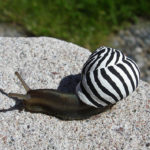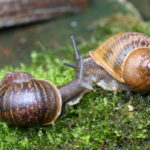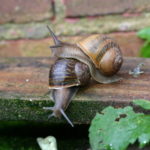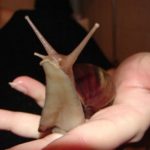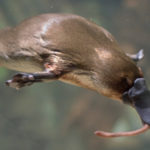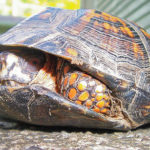Snails
 Snails live in small groups. At night, when it gets cool, they crawl to feed. Eat almost everything: leaves, worms, small larvae of other inhabitants of the forest. And the food is searched for by touch, with tentacles. They see snails badly, their small eyes are only able to distinguish between day and night. But their sense of smell is very good. For example, a slug – a snail without a shell – smells the smell of food, being away from it as much as two meters.
Snails live in small groups. At night, when it gets cool, they crawl to feed. Eat almost everything: leaves, worms, small larvae of other inhabitants of the forest. And the food is searched for by touch, with tentacles. They see snails badly, their small eyes are only able to distinguish between day and night. But their sense of smell is very good. For example, a slug – a snail without a shell – smells the smell of food, being away from it as much as two meters.
Among the snails there are absolutely crumbs, the size of 2-3 millimeters, and there are also giants: their houses the size of three matchboxes, set against each other. They are the ones that cause the most trouble for people.
Everything about snails The warm spring nights of a snail are sent to find their own kind for mating. Finding each other, future parents, start a wedding. They twist, touching each other with tentacles. Sometimes it lasts a few hours. After completing courtship, the snails tightly cling to each other and surround themselves with mucus, so as not to get unstuck during mating. At this time, 10-12 embryos are already found in each cochlea.
Observing the snails, the scientists found that they are most likely to mate in the spring. In general, most snails reproduce throughout the year. The more warm and humid the weather is in the yard, the more prolific they are. They mate as leisurely as they move. All night long, a loving couple can stand, clutching each other “in embrace” in slime.
Well, the snails mated, injected each other with sperm – fertilization took place. Snails creep, and eggs have already begun to grow in them, dressing in shells.
This is amazing, but most snails do not have either males or females. Each of them during mating is both a future father and a future mother. After the snails have firmly adhered, each of them introduces into another a thin white process. It seeps through the sperm. Sperm, as well as embryos, can be in each of the mating snails.
This pairing is an interesting phenomenon. It has been preserved since time immemorial, when animals were not always divided into males and females – they did not have sex. This proves that snails are very ancient creatures that have not changed since then.
A week or two after mating, the snails dig a shallow – centimeter three – hole and lay eggs in it. Then they fill the masonry with earth. A grape snail can lay 30-40 eggs at a time, and in just a few years – several tens of thousands. The fact is that the snail has a lot of enemies. And if they can not catch the snail itself, they eagerly eat its eggs. And beetles, worms, and other small insects consider snail eggs to be the most delicious food and assiduously search for them. So, in the end, only a very small part of the clutches will survive the looting. So, in order not to interrupt the genus of the cochlea, it simply needs to be so prolific.
The snail is so sure that one of her offspring will survive, that she does not consider it necessary to follow the clutch. After laying eggs, she crawls away on her business, and the masonry remains a lonely heap in the ground. Immediately, every small living creature comes running to it. As if only waiting for the snail-mother to abandon her offspring! The feast begins with a mountain …
Someone still manages to survive. The shell on the eggs became thin and almost transparent. So, it’s been three or four weeks already. The young snails are ready to crawl out into the light. Shells are transparent, because small snails feed on them. Finally, they hatch from eggs.
Young snails are very similar to parents, only the shells are small, thin and soft. The first time the snails remain under the ground and feed on the remains of the egg shell. But soon the stock ends. It’s time to get out on the surface.
When young snails crawl out of the ground, they immediately begin to behave like adults. They literally eat everything. But in particular they like green leaves. The tongue of the cochlea is covered with many small sharp teeth. As a saw file “saws off” it from a sheet of small pieces and swallows them. Young snails begin to eat hungrily to grow up faster.


